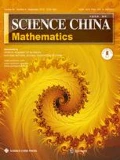Abstract
Let σ = {σi | i ∈ I} be some partition of the set of all primes P. A set H of subgroups of G is said to be a complete Hallσ-set of G if every member ≠ 1 of H is a Hall σi-subgroup of G, for some i ∈ I, and H contains exactly one Hall σi-subgroup of G for every σi ∈ σ(G). A subgroup H of G is said to be: σ-permutable or σ-quasinormal in G if G possesses a complete Hall σ-set H such that HAx = AxH for all A ∈ H and x ∈ G: σ-subnormal in G if there is a subgroup chain A = A0 ≤ A1 ≤ · · · ≤ At = G such that either \({A_{i - 1}}\underset{\raise0.3em\hbox{$\smash{\scriptscriptstyle-}$}}{ \triangleleft } {A_i}\) or Ai=(Ai-1)Ai is a finite σi-group for some σi ∈ σ for all i = 1;:::; t.
If Mn < Mn-1 < · · · < M1 < M0 = G, where Mi is a maximal subgroup of Mi-1, i = 1; 2;...; n, then Mn is said to be an n-maximal subgroup of G. If each n-maximal subgroup of G is σ-subnormal (σ-quasinormal, respectively) in G but, in the case n > 1, some (n−1)-maximal subgroup is not σ-subnormal (not σ-quasinormal, respectively) in G, we write mσ(G) = n (mσq(G) = n, respectively).
In this paper, we show that the parameters mσ(G) and mσq(G) make possible to bound the σ-nilpotent length lσ(G) (see below the definitions of the terms employed), the rank r(G) and the number |П(G)| of all distinct primes dividing the order |G| of a finite soluble group G. We also give the conditions under which a finite group is σ-soluble or σ-nilpotent, and describe the structure of a finite soluble group G in the case when mσ(G) = |П(G)|. Some known results are generalized.
Similar content being viewed by others
References
Agrawal R K. Generalized center and hypercenter of a finite group. Proc Amer Math Soc, 1976, 54: 13–21
Ballester-Bolinches A, Doerk K, Pérez-Ramos M D. On the lattice of F-subnormal subgroups. J Algebra, 1992, 148: 42–52
Ballester-Bolinches A, Esteban-Romero R, Asaad M. Products of Finite Groups. Berlin-New York: Walter de Gruyter, 2010
Ballester-Bolinches A, Ezquerro L M. Classes of Finite Groups. Dordrecht: Springer, 2006
Doerk K, Hawkes T. Finite Soluble Groups. Berlin-New York: Walter de Gruyter, 1992
Guo W. Structure Theory for Canonical Classes of Finite Groups. Heidelberg-New York-Dordrecht-London: Springer, 2015
Guo X, Shum K P. Cover-avoidance properties and the structure of finite groups. J Pure Appl Algebra, 2003, 181: 297–308
Guo W, Shum K P, Skiba A N. X-semipermutable subgroups of finite groups. J Algebra, 2007, 315: 31–41
Guo W, Skiba A N. Finite groups with permutable complete Wielandt sets of subgroups. J Group Theory, 2015, 18: 191–200
Guo W, Skiba A N. Finite groups whose n-maximal subgroups are σ-subnormal. ArXiv:1608.03353, 2016
Guo W, Skiba A N. Finite groups with H-permutable subgroups. Commun Math Stat, 2017, 5: 83–92
Huppert B. Normalteiler und maximale Untergruppen endlicher Gruppen. Math Z, 1954, 60: 409–434
Huppert B. Endliche Gruppen I. Berlin-Heidelberg-New York: Springer-Verlag, 1967
Janko Z. Finite groups with invariant fourth maximal subgroups. Math Z, 1963, 83: 82–89
Kegel O H. Untergruppenverbande endlicher Gruppen, die den subnormalteilerverband echt enthalten. Arch Math, 1978, 30: 225–228
Kniahina V N, Monakhov V S. On the permutability of n-maximal subgroups with Schmidt subgroups. Tr Inst Mat Mekh UrO RAN, 2012, 18: 125–130
Kovaleva V A. Finite groups with generalized P-subnormal second maximal subgroups. Asian-Eur J Math, 2014, 7: 1450047
Kovaleva V A, Skiba A N. Finite soluble groups with all n-maximal subgroups F-subnormal. J Group Theory, 2014, 17: 273–290
Kovaleva V A, Yi X. Finite biprimary groups with all 3-maximal subgroups U-subnormal. Acta Math Hungar, 2015, 146: 47–55
Li S. Finite non-nilpotent groups all of whose second maximal subgroups are TI-groups. Math Proc R Ir Acad, 2000, 100: 65–71
Li B, Skiba A N. New characterizations of finite supersoluble groups. Sci China Ser A, 2008, 51: 827–841
Mann A. Fnite groups whose n-maximal subgroups are subnormal. Trans Amer Math Soc, 1968, 132: 395–409
Monakhov V S, Kniahina V N. Finite groups with P-subnormal subgroups. Ric Mat, 2013, 62: 307–322
Shemetkov L A. Formations of Finite Groups. Moscow: Nauka, Main Editorial Board for Physical and Mathematical Literature, 1978
Shemetkov L A, Skiba A N. Formations of Algebraic Systems. Moscow: Nauka, Main Editorial Board for Physical and Mathematical Literature, 1989
Skiba A N. On σ-subnormal and σ-permutable subgroups of finite groups. J Algebra, 2015, 436: 1–16
Skiba A N. A generalization of a Hall theorem. J Algebra Appl, 2015, 15: 21–36
Skiba A N. On some results in the theory of finite partially soluble groups. Commun Math Stat, 2016, 4: 281–312
Spencer A E. Maximal nonnormal chains in finite groups. Pacific J Math, 1968, 27: 167–173
Vasil'ev A F, Kamornikov A F, Semenchuk V N. On lattices of subgroups of finite groups (in Russian). In: Infinite Groups and Related Algebraic Structures. Kiev: Institum Matemayiki AN Ukrainy, 1993, 27–54
Weinstein M. Between Nilpotent and Solvable. Passaic: Polygonal Publishing House, 1982
Acknowledgements
This work was supported by National Nature Science Foundation of China (Grant No. 11771409) and Wu Wen-Tsun Key Laboratory of Mathematics of Chinese Academy of Sciences. The authors thank the referees for their careful reading and helpful comments.
Author information
Authors and Affiliations
Corresponding author
Rights and permissions
About this article
Cite this article
Guo, W., Skiba, A.N. Finite groups whose n-maximal subgroups are σ-subnormal. Sci. China Math. 62, 1355–1372 (2019). https://doi.org/10.1007/s11425-016-9211-9
Received:
Accepted:
Published:
Issue Date:
DOI: https://doi.org/10.1007/s11425-016-9211-9
Keywords
- finite group
- n-maximal subgroup
- σ-subnormal subgroup
- σ-quasinormal subgroup
- σ-soluble group
- σ-nilpotent group


